Credit where it's due. Ducati kicked the whole adventure-touring segment in the ass with the second-generation Multistrada by asking a simple question: Why couldn't an ADV machine have the kind of serious performance and hard edge of a sportbike, just without the hard-over ergonomics and lack of practicality? Indeed, why not. Since 2010, the Multi has been one of Ducati's success stories, prolonging the brand relationship with existing customers and bringing in a whole flock of new ones.
BMW was not about to stand idly by. Yes, the R1200GS is the latest incarnation of an epically popular and durable franchise. So much so that all you need to say are the initials. "What kind of bike do you ride?" "A GS." "Oh, yeah, that's a good one." But hard core it is not, preferring the route of the generalist; do everything well—better, even, than anyone expects—but keep performance in balance. Because of this emphasis, Munich has taken a few knocks from Bologna, which it is most definitely not accustomed to.
With the S1000XR, BMW is saying “hell with that!” So you want an ADV-styled machine with real performance—here it is. BMW puts the target in simple terms. The XR is for “…riders who want the broad bandwidth of usability offered by a touring adventure bike; riders interested in a more powerful version of the GS or an alternative to the GS; roadster riders looking for more protection against wind and weather, but who prefer the XR’s riding position to an alternative sports touring machine like the K1300S; and sport-touring riders searching for something with a new look.” Did we miss anybody? Also worth noting is that BMW hopes the XR will steal customers away from other brands. The Double R had by far the greatest “acquisition rate” of any BMW, and the firm looks to try the magic again with the XR.
Bavaria didn't need to start fresh to find fresh alchemy, since the S1000RR last year gave birth to the “single R” naked bike, whose slightly revised (modestly detuned) engine and lightly updated chassis were close enough to accept a half fairing (mit beek!), taller suspension, and the rest of the ADV jewelry. Good to go.
More than good, actually. The S1000XR is an amazing thing. It starts with that engine, a 999cc powerhouse that gets max power reduced to 160 hp to affect an increase in torque. With a peak of 83 pound-feet at 9,250 rpm, the XR spots the new DVT version of the Multi almost 17 pound-feet; remember the Ducati’s displacement advantage. Both bikes have the same peak horsepower.
More than a sum of its numbers, the BMW’s inline-four produces those ponies with contemptuous ease, even on the bikes we rode with virtually no mileage on them. (In fact, because they had not had their first service, the rev limiter kicked in at 9,000 rpm, two grand short of the real redline.) Once you get past a bit of softness right at the bottom of the rev range, the Beemer’s four climbs the torque hill like a champ, eventually reaching 6,000 rpm where it gets a second wind in the sprint to the 11-grand redline. Because our bikes were limited to 9,000 rpm, not only was peak horsepower unavailable, so was peak torque. (The last S1000R we tested put down 152.3 hp at 10,900 rpm and 78.2 pound-feet of torque at 9,400 rpm.) And while not all the high-rev ponies were available, there was still more than enough to thrill, especially given that it rained for much of the test route near the beautifully green Muskoka Lakes resort area.
[UPDATE: After the first service at BMW's New Jersey HQ, the S1000XR has been fully unleashed, and the top-end glory we all know from the S1000R is fully present and accounted for. Let's just say this: Few four-cylinder engines have the kind of high-rpm wail and shimmering presence in the powerband. The XR's 999cc mill feels like it escaped the Formula One paddock.]
Sketchy conditions highlighted the strength of the XR’s electronic package. Taking the basic platform from the S1000R, the XR gets multi-mode traction control and optional lean-angle-informed ABS along with various ride modes. As with other recent BMWs, you need to option up to get the good stuff. The base XR gets standard ABS and simplified TC, but when you get the Ride Modes Pro option (part of the $18,750 Premium package or a $450 upgrade on the base bike), you also get additional ride modes, Dynamic Traction Control, and, as a first on a BMW, ABS Pro, which is the term for lean-angle ABS. One more thing: BMW also sends each bike out with a programming plug under the seat. Your bike will probably arrive with this device unplugged. Plug it in! You’ll get an additional layer of electronic flexibility. (See the chart below.) Note that with the Dynamic Pro ride mode selected, wheelies are permitted and rear-wheel lift detection is turned way down to permit stoppies. Moreover, the Ride Modes Pro option provides an additional layer of damping control when you have Dynamic ESA installed. (All the more reason to opt for the Premium package, which includes all the good stuff.)
We started our test ride in Rain mode, where throttle response is softer and ABS/TC intervention levels are heightened. On some of the slickest roads, the TC light would flash but only after being intentionally aggressive with the throttle. In Road mode, the XR was equally docile but got into the electronic nannies much less often, itself an indication of the chassis’ ability to put down power and the quality of the stock Bridgestone T30s.
Riding a powerful machine in the wet, on some really weather-beaten roads, should be a bit clench-inducing, but the XR made it easy. You’re sitting upright, reaching slightly forward to a tall, wide handlebar, balanced comfortably on a well-shaped (but suspiciously thin) saddle. It’s easy to keep your head up and body balanced with this arrangement, so when the front starts to nibble or the rear begins to step out, it’s rarely a surprise. Great leverage from the wide bar makes steering effort light and the chassis responsiveness quick—exactly what you’d expect, without negative side effects.
That alloy chassis provides excellent communication from the contact patches. And while it looks much like the S1000R’s, there are a number of refinements for XR duty. Suspension travel is up, 5.9 inches front and 5.5 inches rear (versus 4.7 each end for the R), wheelbase has grown to 61 inches from 56.7, trail gains 0.7 inches to 4.6, and the rake has been kicked out to 25.5 from 24.6 degrees. But consider some additional perspective: By most measurements, the BMW is taller, longer, and heavier than the new Multistrada.
The XR also, if memory serves us well, owns more softly calibrated suspension than the Ducati. As with other D-ESA setups, the XR’s gets dynamically adjusted compression and rebound damping along with variable rear spring preload. Damping rates vary by ride mode as well as by independent suspension modes, including Road and Dynamic. This is a slight change of nomenclature for BMW, which used to have three sub-settings for the suspension. Now it's basically two, Road (the baseline) and Dynamic (firmer).
Definitely starchier than a GS's, the XR's legs soak up small bumps extremely well while keeping the whole mess nicely under control with a minimum of float. BMW's experience with D-ESA is starting to show ever more brightly with every new iteration. Moreover, BMW has refined one aspect of the S1000R we didn't all agree on—the brakes. On the R, the front brakes are aggressive to the point of distraction (for some riders), but on the XR a change of some kind—we couldn't get clarification if it was an electronic alteration or just different pads—has taken some of the bite out. A bit of the S1000R's lever slop—the handle moves a fair amount before any braking action commences—remains, however.
There are a few unanswered questions. While the XR gets the same Gear Shift Assist Pro option as the current RR, enabling clutchless shifts in both directions with a snorty throttle blip going down, the XR we rode still had a lot of stiffness in the shifter. That could change with miles. Also, our bike had a few tingles up and down the rev range, including a resonance at 5,000 rpm, or right in the normal highway cruise zone. We'll see if that gets better with miles. [UPDATE: That vibration is diminishing slightly as our XR gains miles, but another solution is to simply go faster. At 6,000 rpm the engine hits a slightly smoother zone.] We hope the vibration dissipates because the rest of the "touring" part of the XR's mandate is well handled, from weather protection to ergonomic comfort to the opportunity to fit hard luggage. Plus heated grips, cruise control, and a tidy GPS installation package that uses the left-grip finger wheel. It's a nicely complete package in the BMW way.
And now the last burning question: Will the XR dethrone the Multistrada as the most sporting of road-biased ADV machines? We’ll know very soon, as the red bike you see here is on its way to the west coast and an awaiting Ducati Multistrada DVT. Let the ass-kicking begin.













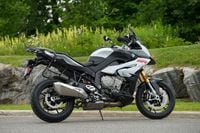


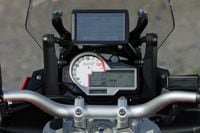

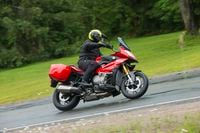




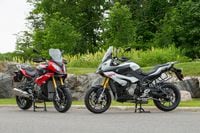












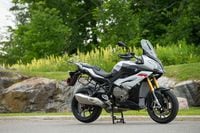


















/cloudfront-us-east-1.images.arcpublishing.com/octane/B6XD6LS6IVCQPIU6HXDJSM3FHY.jpg)
/cloudfront-us-east-1.images.arcpublishing.com/octane/ICL63FEDDRDTTMINYICCEYGMDA.jpg)
/cloudfront-us-east-1.images.arcpublishing.com/octane/FCGZHQXRBZFLBAPC5SDIQLVF4I.jpg)
/cloudfront-us-east-1.images.arcpublishing.com/octane/WNOB6LDOIFFHJKPSVIWDYUGOPM.jpg)

/cloudfront-us-east-1.images.arcpublishing.com/octane/X33NU3E525ECRHXLNUJN2FTRKI.jpg)
/cloudfront-us-east-1.images.arcpublishing.com/octane/6KKT5NNL2JAVBOXMZYS5ZO76YA.jpg)
/cloudfront-us-east-1.images.arcpublishing.com/octane/J5RKG5O455GMPGQRF2OG6LRT7A.jpg)
/cloudfront-us-east-1.images.arcpublishing.com/octane/GX2CIZKQVRH2TATDM26KFG2DAE.jpg)
/cloudfront-us-east-1.images.arcpublishing.com/octane/ZWIDYSAKQZHD5BHREMQILXJCGM.jpg)
/cloudfront-us-east-1.images.arcpublishing.com/octane/CYUHJZCTSJCH3MRAQEIKXK7SCQ.jpg)
/cloudfront-us-east-1.images.arcpublishing.com/octane/LKOFINY56FCXJCANJ5M7ZDQUBY.jpg)
/cloudfront-us-east-1.images.arcpublishing.com/octane/4NBPDACMWJH63JQYJVK3QRBDZI.jpg)
/cloudfront-us-east-1.images.arcpublishing.com/octane/KKHQHRR3FJGX7H2IPU6RALMWG4.jpg)

/cloudfront-us-east-1.images.arcpublishing.com/octane/5IOFS5JAE5FOXMNA23ZRAVVYUU.jpg)
/cloudfront-us-east-1.images.arcpublishing.com/octane/CGXQ3O2VVJF7PGTYR3QICTLDLM.jpg)

/cloudfront-us-east-1.images.arcpublishing.com/octane/OQVCJOABCFC5NBEF2KIGRCV3XA.jpg)
/cloudfront-us-east-1.images.arcpublishing.com/octane/OPVQ7R4EFNCLRDPSQT4FBZCS2A.jpg)
/cloudfront-us-east-1.images.arcpublishing.com/octane/YBPFZBTAS5FJJBKOWC57QGEFDM.jpg)
/cloudfront-us-east-1.images.arcpublishing.com/octane/W5DVCJVUQVHZTN2DNYLI2UYW5U.jpg)
/cloudfront-us-east-1.images.arcpublishing.com/octane/C3VIRIAYNZCTJAZNRLREDS3JCM.jpg)
/cloudfront-us-east-1.images.arcpublishing.com/octane/XXWKUKITWRAF3HCJAWGJ25V7BA.jpg)